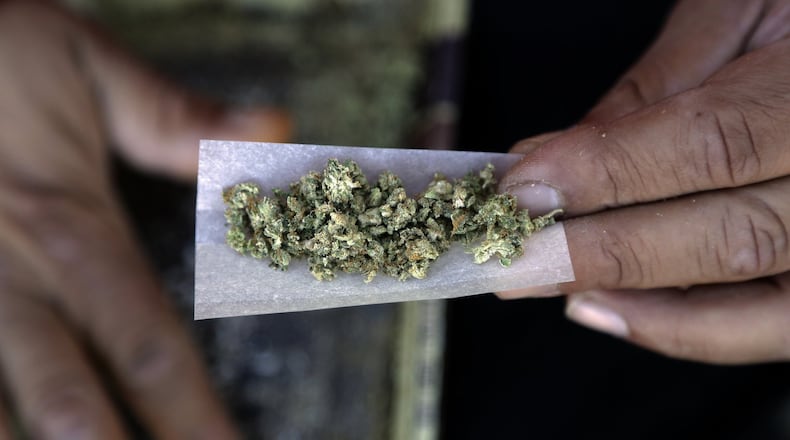Overall, about 4.2 percent of the U.S. workforce tested positive last year for drugs, including cocaine, methamphetamine, marijuana and heroin. It was the highest national rate since 2004 when the share of positives tests was 4.5 percent, according to Quest, which analyzed more than 10 million workforce drug test results nationwide.
The trend is being dealt with differently by industries. For the trucking industry, there is a zero-tolerance policy because of the mayhem impaired drivers can cause. But leaders in some other industries are considering relaxing their standards rather than risk losing employees.
Tragedies such as what occurred to former Spirit Airlines pilot Brian Halye and his wife Courtney in Centerville reveal the extent to which growing drug use is hitting all parts of society. Neighbors of the Centerville couple still shake their heads in disbelief at their deaths in March , according to Tony Miltenberger, pastor at Centerville United Methodist Church who is a former drug counseling pastor at Ginghamsburg United Methodist Church in Tipp City.
“The new reality is that there is nowhere, not even in the suburbs, where you are exempt from the drug problem, specifically heroin,” Miltenberger said. “We see that in Centerville as much as we see that anywhere.”
RELATED: Drug deaths mar county health rankings
The reality is still hard for some residents to accept, Miltenberger said: “Most people are willing to admit that it’s everywhere, but not everyone is willing to admit that it could be in their homes or at the office,” he said.
Evidence suggests there are thousands of users who are employed but whose addiction and drug use remain in the closet until it is exposed by a workplace drug test.
RELATED: Heroin fight strains addiction services
The findings “are remarkable because they show increased rates of drug positivity for the most common illicit drugs across virtually all drug test specimen types and in all testing populations,” said Barry Sample, senior director of science and technology at Quest Diagnostics Employer Solutions. “Our analysis suggests that employers committed to creating a safe, drug-free work environment should be alert to the potential for drug use among their workforce.”
In Ohio, the overall rate of positive drug tests was 3.7 percent, slightly lower than the national rate. But in some parts of the Miami Valley — including the suburbs of Dayton and nearby counties — the share of workers who have tested positive for illicit drugs is significantly higher than the state and national rates, and has spiked sharply in recent years.
RELATED: Failed drug tests holding back employment
In Warren and Butler counties, positive test rates ranged from 3.5 percent to 4.5 percent last year, up from a range of 2.5 to 3.5 percent in 2010, according to the testing company’s analysis of urine drug test results. The overall rate in Montgomery County was also above average at 3.5 to 4.5 percent last year, unchanged from 2010.
Those figures are still way down from the late 1980s and early 1990s when the rate hovered around 15 percent, according to Quest. The recent spike in positive drug tests has become a drag on employment and productivity as local employers complain they can’t fill open positions because they can’t find enough qualified workers who can pass drug tests.
The situation has led some employers to relax workplace drug-testing policies to accommodate skilled workers who use drugs, and give them greater latitude to seek help for their drug problems. As far back as 2014 former FBI Director James Comey said the agency may have to loosen its policy on pre-employment marijuana use for its job candidates in order to be able to hire enough tech and cyber-crime experts.
But that’s not an option in many environments where workplace safety is tantamount, and impaired workers pose deadly risks to themselves and others around them.
RELATED: Drug use passes drinking in fatal crashes
“We’ve got 80,000 pound trucks going up and down the Interstate, and there isn’t any second chance when you’re involved in an accident with a tractor trailer,” said Kevin Burch, owner of Jet Express Inc. in Dayton, and chairman of the American Trucking Associations. “So we can’t afford to give employees a second chance who’ve had situations with previous drug abuse and can’t pass a test.
“In our industry, drivers know they’re going to be tested before they get the job, and they’re going to be randomly tested,” Burch said. “So if you’re abusing drugs, chances are you won’t be behind the wheel of a truck.”
Less than 1 percent of workers in the trucking industry and other federally-regulated, safety-sensitive industries — including the airline and manufacturing industries — test positive for drugs on an annual basis. But even those numbers have begun to rise.
Positive tests for marijuana alone increased nearly 10 percent in federally-regulated industries in just the past year (from 0.71 percent in 2015 to 0.78 percent in 2016), the largest year-over-year increase in five years, according to Quest.
RELATED: Medical marijuana doesn't trump zero tolerance in Ohio
Marijuana remains the most common narcotic that workers test positive for, with the rate of use climbing over the past several years from about 1.6 percent of all tests in 2012 to 2 percent last year. More states, including Ohio, have legalized it for medical or recreational purposes.
But the main driver behind the increase in positive tests over the past several years has been positive tests for heroin, which increased from 0.020 percent of all tests in the general U.S. workforce in 2012 to 0.028 percent in 2016 — a 40 percent increase in the rate.
—
By the numbers
14.8 million: Estimated number of Americans who abuse drugs.
70: Percentage of those Americans who are employed.
4.2: Percentage of the U.S. workforce that tested positive last year for drugs, including cocaine, methamphetamine, marijuana and heroin.
10: Percentage increase in positive marijuana tests in federally-regulated, safety-sensitive industries.
Source: Quest Diagnostics Inc., National Council on Alcoholism and Drug Dependence.
About the Author
